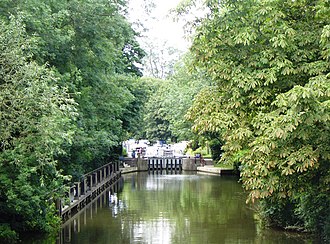Whitchurch Lock

Whitchurch Lock is a lock and weir situated on the River Thames in Oxfordshire. It is on an island near the village of Whitchurch-on-Thames and is inaccessible except by boat. It is a pound lock, built by the Thames Navigation Commissioners in 1787.
The weir crosses the river to the Berkshire village of Pangbourne.
History
There was a flash lock recorded at Whitchurch in the 16th century. Near the southern bank, there was a sluice which was 30 ft wide which was fitted with flood gates and overfall boards, to accommodate a drop of 3 to 4 ft in the river level. The flash lock was in the centre, with a winch on the north bank to haul the barges through against the current. It was 23 ft wide, which was the standard size for all flash locks below Abingdon. Near to the island was a "tumbling bay", an overfall weir with its crest just below normal low water level. It was about 35 ft wide. In common with most of the weirs on the Thames, the width of the tumbling bay was gradually increased, until it formed most of the weir, apart from the sluice.[1]
The pound lock, built of oak, was installed at the island in the summer of 1787. Two alternative sites were originally considered. One would have expanded the mill stream on the Whitchurch side, and another would have involved a cut across land occupied by the Swan public house at Pangbourne. A lock house was built on the island in the 1830s. In the later 19th century local people used to cross over the weir to avoid paying tolls on the bridge. The lock was rebuilt in 1876 and access across the weir was closed. The right of way from Whitchurch to the lock was closed in 1888.[2]
Access to the lock
Whitchurch Lock is the only lock on the River Thames which has no public access other than by boat.
Reach above the lock

The reach passes along the Chiltern Hills, culminating in Goring Gap. Halfway along the reach is the Gatehampton Railway Bridge.
The hills on the Oxfordshire side are populated by houses at Whitchurch and are then covered by the Hartslock beech woods. This name derives from a lock among the islands below the hills. This had become disused by the time the pound locks were built, but the obstructions remaining from it were not removed until 1910.[2] The river turns west away from the hills leaving flat meadows up to Goring.
On the Berkshire side the river passes the river side at Pangbourne where there are seven distinctive Edwardian-style houses overlooking the river. These were built by D. H. Evans the shop owner and were nicknamed the "Seven Deadly Sins" as it was alleged that he kept a mistress in each of them.[3] Beyond this point is Beale Park and set back from the river is Basildon Park. The river turns north again at the Goring Gap where the hills on the Streatley side overshadow the river. Just before the Goring Lock is Goring and Streatley Bridge.
Pangbourne College is based on this stretch of the river and the Pangbourne Junior Sculls take place on the reach in November.
The Thames Path, having crossed Whitchurch Bridge, continues away from the river through the streets of Whitchurch and then through the woods. This is a section with steep inclines and long flights of steps. Once back to the river side at Hartslock, it continues on the Oxfordshire bank to Goring.
See also
References
- Location map: 51°29’12"N, 1°5’18"W
- ↑ Skempton 1996, pp. 154-155.
- ↑ 2.0 2.1 Fred. S. Thacker The Thames Highway: Volume II Locks and Weirs 1920 - republished 1968 David & Charles
- ↑ Paul Goldsack River Thames: In the Footsteps of the Famous English Heritage/Bradt 2003
Bibliography
- Skempton, Alec (1996). Civil Engineers and Engineering in Britain, 1600-1830. Variorum. ISBN 978-0-86078-578-1.